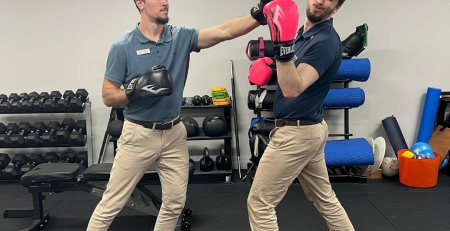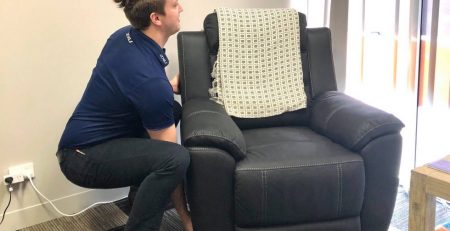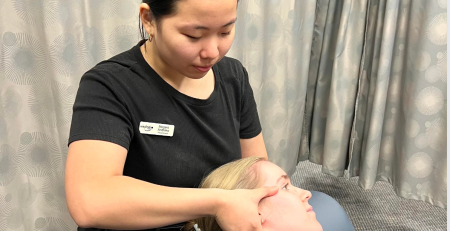My Journey with Degenerative Meniscal Knee Pain: Trusting that it will get better.
Written by Sarah Clay, Senior Physiotherapist.
Back in August 2020, after a big week of squatting at the gym, backed up by an 18km hike, I ended up with a swollen, painful right knee. This was particularly frustrating as I was still going through a rehabilitation process, having dislocated my shoulder traumatically back in April 2020. Anyone who has suffered significant musculoskeletal injuries will identify with this frustration!
Anyway, my first thoughts, of course were what have I damaged, and how? It is easy to get fixated on the idea that I had structurally damaged something and go straight down the path of getting scans and further investigations done. Understandable, as I walked with a significant limp, had pain on the inside of my knee all the time (made worse with doing things like stairs). It was waking me at night time, I couldn’t bend it past 90° and there was a large effusion or swelling.
As a Physiotherapist, with significant knowledge in this area, I had to reason with myself. Clinically, it was presenting as a degenerative meniscal problem, likely with a large Bakers Cyst. The meniscus is a ‘C’ shaped piece of cartilage that sits between the thigh and shin bone. There are two of these in each knee, a medial one and a lateral one. Their roles are thought to be in load bearing, providing shock absorption and in lubricating the articular cartilage of the knee. A degenerative tear or damage results from repetitive ‘normal’ forces on an ageing meniscus (I am 54 years old!). Studies have shown that physical examination is sufficient to diagnose degenerative meniscal tears with around 90% accuracy, very similar to the accuracy of MR scans. It was still very tempting during this process to have a scan done though. Illogical, when you consider the above and on top of that the huge expense to myself as well as the Medicare system when it is not necessary, nor would it change the outcome. It is also likely that the tear was pre-existing, even though I had a pain free knee prior to this. Research confirms that over 30 % of the pain free adult population have tears that are asymptomatic!
Why would an MRI not change the outcome? Most of us know someone who has had arthroscopic surgery for meniscal tears, surely that would be an option for a problem like mine once confirmed on MRI? So lets talk about surgical options for this sort of problem……
1/. Menisectomy.
Arthroscopic( or keyhole) surgery to remove damaged meniscus. These are usually partial. The days of complete menisectomies are gone, as longterm outcomes are poor with accelerated rates of osteoarthritis being a researched finding.
So what about a partial Menisectomy? The long term outcomes of conservative management (no surgery, but undergo exercise rehabilitation) have been shown to provide similar results as surgery!
2/. Repair.
The indications for this are limited as it is not an option at all for tears in the inner 2/3rds of the meniscus due to poor blood supply and outcomes are not guaranteed to outer 1/3rd tears either.
But, despite studies showing that arthroscopic surgery is not more helpful in treating these problems many surgeons still believe it is appropriate and are happy to perform this type of operation.
Obviously, I chose a conservative approach.
What did this look like?……..
1/. Relative rest.
Resting from activities that were likely to delay progress or flare the problem. This was difficult for me, firstly because I am an avid exerciser and part of a Crossfit community for about 10 years. Secondly, because I work on weekends as an outdoor adventure guide which typically involves a lot of hiking! I adjusted my hiking to always using my walking poles to decrease the load through my knee, made sure I had appropriate sleep leading up to and after these hikes as well! So important for any recovery.
2/. Kept exercising.
I had to find ways of still participating at Crossfit, as this was important to me for many reasons.
- Movement provides nutrition to the knee joint and surrounding structures and stops it getting stiff.
- Strengthing of surrounding muscles supports and off loads the symptomatic knee
- Exercise is a tool for stress relief for myself
- If I stop exercising, I increase my risk of heart disease, stroke, dementia and other chronic diseases.
3/. Nutrition.
Maintaining good nutrition is important. Inflammatory metabolic disorders, caused by poor nutrition may be associated with increased inflammation in problems like this.
4/. Non Steroidal Anti- inflammatory medication.
My personal preference was to limit the use of these, but I did use them in the early stages to help with a good nights sleep and also help with reducing the effusion or swelling.
5/. Trust and self talk.
Trusting my knowledge that it would get better and re-assuring myself that I was on the right track with recovery . Telling myself that even though I was getting sone discomfort whilst exercising, it was not causing further damage. (For the patient, who is not a Physio this would be trusting the information and path from their Physiotherapist who guiding them on in their recovery).
This has worked well for me, but it has been a slow process. It is now more than 16 weeks since onset of this problem. I have done my first trail run, can jump, lunge and body weight squat and have near full range of movement. My next challenge is to start adding weight to my squats!
The reality for many people who develop this type of problem, is often the opposite. They become fearful of movement and using the knee, believing it is susceptible to further damage. They self impose rest and have a declining level of activity, which leads to poor outcomes and potentially a multitude of other problems.
If you have knee pain that fits this bill, see one of our Physiotherapists who can guide you through the process.
Reference
- Faunø, P., & Nielsen, A. B. (1992). Arthroscopic partial meniscectomy: A long-term follow-up. Arthroscopy: The Journal of Arthroscopic & Related Surgery, 8(3), 345-349.
- Grant, J. A., Wilde, J., Miller, B. S., & Bedi, A. (2012). Comparison of inside-out and all-inside techniques for the repair of isolated Meniscal tears: a systematic review. The American Journal of Sports Medicine, 40(2), 459-468.
- Herrlin, S., Hållander, M., Wange, P., Weidenhielm, L., & Werner, S. (2007). Arthroscopic or conservative treatment of degenerative medial meniscal tears: A prospective randomised trial. Knee Surgery, Sports Traumatology, Arthroscopy, 15(4), 393-401.
- Horga, L. M., Hirschmann, A. C., Henckel, J., Fotiadou, A., Di Laura, A., Torlasco, C., D’Silva, A., Sharma, S., Moon, J. C., & Hart, A. J. (2020). Prevalence of abnormal findings in 230 knees of asymptomatic adults using 3.0 T MRI. Skeletal Radiology.
- Howell, R. (2014). Degenerative meniscus: Pathogenesis, diagnosis, and treatment options. World Journal of Orthopedics, 5(5), 597.
- Katz, J. N., Brophy, R. H., Chaisson, C. E., & Chaves, L. D. (2013). Surgery versus physical therapy for a Meniscal tear and osteoarthritis. New England Journal of Medicine, 368(18), 683-683.
- Khan, M., Evaniew, N., Bedi, A., Ayeni, O. R., & Bhandari, M. (2014). Arthroscopic surgery for degenerative tears of the meniscus: A systematic review and meta-analysis. Canadian Medical Association Journal, 186(14), 1057-1064.
- Lee, D., Park, Y., Kim, H., Nam, D., Park, J., Song, S., & Kang, D. (2018). Arthroscopic meniscal surgery versus conservative management in patients aged 40 years and older: A meta-analysis. Archives of Orthopaedic and Trauma Surgery, 138(12), 1731-1739.
- Mordecai, S. C. (2014). Treatment of meniscal tears: An evidence based approach. World Journal of Orthopedics, 5(3), 233.
- Nepple, J. J., Dunn, W. R., & Wright, R. W. (2012). Meniscal repair outcomes at greater than five years. The Journal of Bone and Joint Surgery-American Volume, 94(24), 2222-2227.
- Rathleff, C. R., Cavallius, C., Jensen, H. P., Simonsen, O. H., Rasmussen, S., Kaalund, S., & Østgaard, S. E. (2013). Successful conservative treatment of patients with MRI-verified meniscal lesions. Knee Surgery, Sports Traumatology, Arthroscopy, 23(1), 178-183.
- Rogers, M., Dart, S., Odum, S., & Fleischli, J. (2019). A cost-effectiveness analysis of isolated Meniscal repair versus partial meniscectomy for red-red zone, vertical Meniscal tears in the young adult. Arthroscopy: The Journal of Arthroscopic & Related Surgery, 35(12), 3280-3286.
- Roos, H., Lauren, M., Adalberth, T., Roos, E. M., Jonsson, K., & Lohmander, L. S. (1998). Knee osteoarthritis after meniscectomy: Prevalence of radiographic changes after twenty-one years, compared with matched controls. Arthritis & Rheumatism, 41(4), 687-693.
- Stensrud, S., Roos, E. M., & Risberg, M. A. (2012). A 12-Week exercise therapy program in middle-aged patients with degenerative meniscus tears: A case series with 1-Year follow-up. Journal of Orthopaedic & Sports Physical Therapy, 42(11), 919-931.
- van de Graaf, V. A., Wolterbeek, N., Mutsaerts, E. L., Scholtes, V. A., Saris, D. B., De Gast, A., & Poolman, R. W. (2016). Arthroscopic partial meniscectomy or conservative treatment for Nonobstructive Meniscal tears: A systematic review and meta-analysis of randomized controlled trials. Arthroscopy: The Journal of Arthroscopic & Related Surgery, 32(9), 1855-1865.e4.
- Vanderhave, K. L., Moravek, J. E., Sekiya, J. K., & Wojtys, E. M. (2011). Meniscus tears in the young athlete. Journal of Pediatric Orthopaedics, 31(5), 496-500.
- Østerås, H., Østerås, B., & Torstensen, T. A. (2012). Medical exercise therapy, and not arthroscopic surgery, resulted in decreased depression and anxiety in patients with degenerative meniscus injury. Journal of Bodywork and Movement Therapies, 16(4), 456-463.
- Van de Graaf, V. A., Noorduyn, J. C., Willigenburg, N. W., Butter, I. K., De Gast, A., Mol, B. W., Saris, D. B., Twisk, J. W., & Poolman, R. W. (2018). Effect of early surgery vs physical therapy on knee function among patients with Nonobstructive Meniscal tears. JAMA, 320(13), 1328.
Author

Sarah Clay
Senior Physiotherapist
Senior Pilates Instructor
South Australian Institute Technology 1987
Sarah is an experienced Physiotherapist with over 30 years industry musculoskeletal experience. She passionate about facilitating change in peoples lives holistically, especially those with chronic or complex pain. She has a special interest in Cognitive Functional Techniques and is currently undergoing further, extensive training in this area, centred around low back pain.
Her holistic approach has involved extra training in Nutrition as well as breathing disorders and techniques.
Sarah heads up our Pilates team, running Clinical Pilates sessions and training other physiotherapists in Pilates.
To read more about Sarah’s experience, click here.











